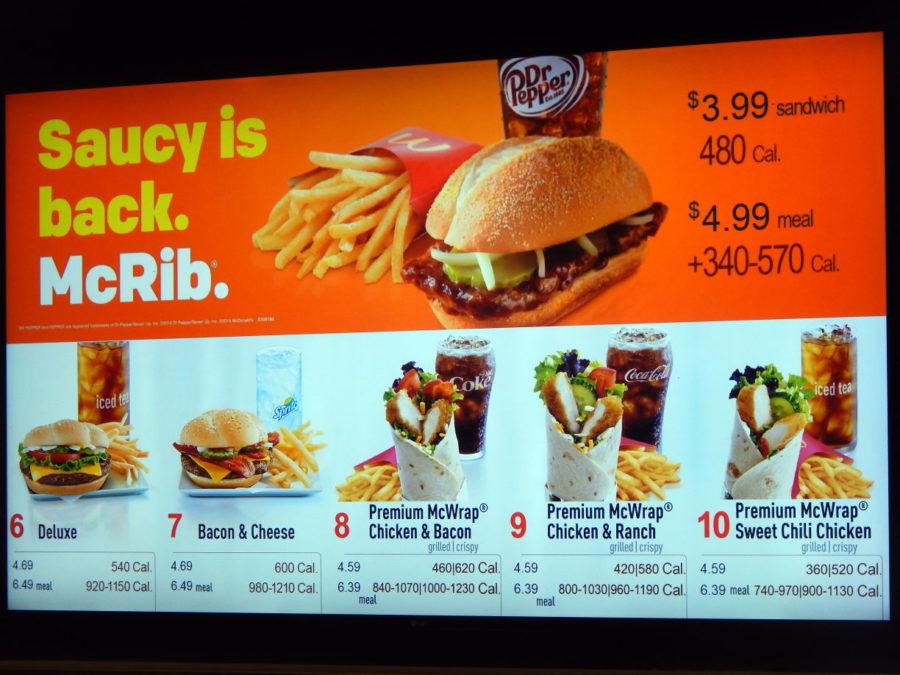Visible food calorie count will be new norm for restaurants
Dec 9, 2014
Last updated on Nov. 28, 2016 at 09:10 p.m.
From burrito bowls to cinnamon rolls, restaurants on campus with more than 20 locations will soon show how many calories are in all of their menu items.
As of Dec. 1, food labeling requirements by the U.S. Food and Drug Administration require restaurants and vending machines to make calories visible to their customers.
Jennifer Corbett Dooren, spokeswoman for the FDA, said in an email that restaurants have one year to comply, but vending machines have two years to fulfill the requirement. Calorie information will need to be posted on menu boards, printed menus and on the menus available on drive-through boards, she said.
“In other words, items listed on a menu will need to have a calorie count — There are exceptions for daily specials or made-to-order items that wouldn’t be on a standard menu,” Dooren said.
Get The Daily Illini in your inbox!
Nikki DeAngelis, senior in ACES, is taking courses in dietetics to become a registered dietician, and said she believes the legislation will not automatically change American behavior toward making better nutritional choices. She said the effects of this new law on Americans’ choices depends on the individual.
“It’s a good resource and a good tool for people to use. It’s not going to make people eat healthier automatically,” DeAngelis said. “I think people should take it into consideration when they order, but it’s still a personal responsibility to make sure you’re eating properly for your body.”
According to the FDA, one-third of calories consumed by Americans is away from home, including both food and drink.
In addition to posting the number of calories in a meal, menus and menu boards will need to post this message: “Additional nutritional information available upon request.”
Customers will have access to the “total calories, calories from fat, total fat, saturated fat, trans fat, cholesterol, sodium, total carbohydrates, fiber, sugars and protein” that meals entail, according to the FDA.
To assist consumers in choosing meals according to their daily food consumption, menus and menu boards must also print the statement: “2,000 calories a day is used for general nutrition advice, but calorie needs vary.”
Brenna Ellison, professor in ACES, has done a study on the effect calorie labels have on what people choose to eat, titled “Looking at the Label and Beyond: The Effects of Calorie Labels, Health Consciousness, and Demographics on Caloric Intake in Restaurants.”
She said the study lasted for 16 weeks and three different menus were used: one with no calorie labels, one with the number of calories next to the meal and one with the number of calories and symbols of traffic lights colored either green (400 calories or less), yellow (401 to 800 calories), or red (over 800 calories).
The study found that the menu with the traffic light symbols was the most influential at changing people’s behavior and getting them to order less calories. Ellison hopes the new labeling law will help people to be more informed, but she is less sure if it will be effective in getting people to make lower-calorie choices.
She also said that some people may not want traffic signals next to meals on menus because some individuals do not want to be told what they should or should not eat.
This semester Ellison is working on a study in the University dining halls observing food being eaten by students.
She added that it may be harder for students to be mindful of how many calories they eat because food at the dining halls is easily available and students are not physically taking money out of their pocket to eat, unlike when someone goes to a restaurant or goes to buy food from a supermarket.
As a college student, DeAngelis understands the obstacles many students face when it comes to eating nutritiously. While it can be difficult to find time to cook, she believes there are things people should take into consideration while making choices about the food they eat.
“My best advice is just be prepared if you’re going out to eat. There are actually a lot of restaurants on our campus that are already posting the calorie amount,” she said. “You can either just take a minute to look at the menu before you order, or if the calorie information is not posted. Just be smart.
Ali can be reached at [email protected].






